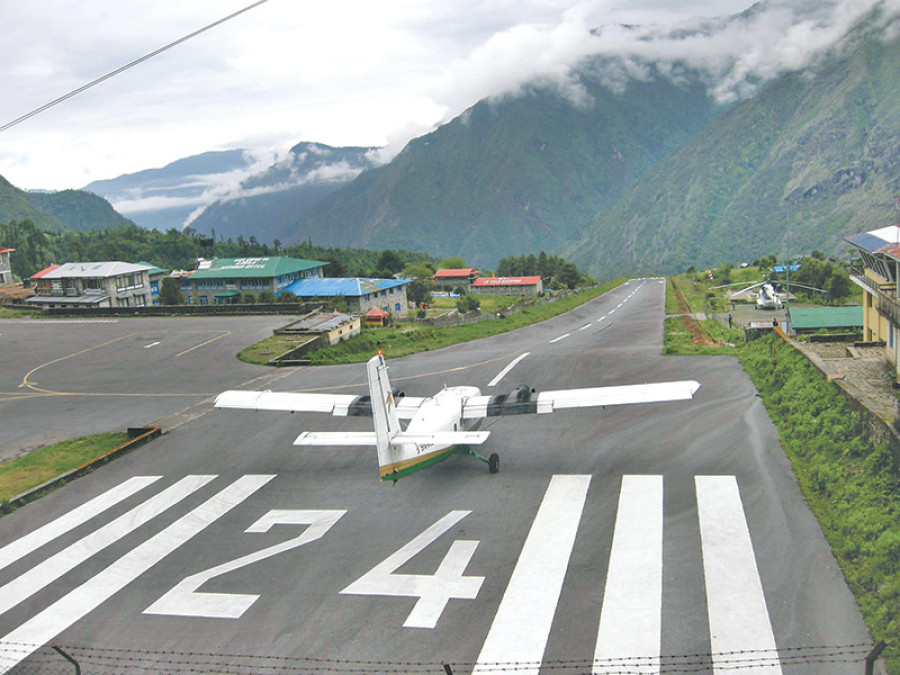Miscellaneous
No go-around
A typical day at the Lukla Airport—high volume of air traffic and deteriorating weather. According to standard procedures, I along with my manager decide to close the airport. Having worked as Air Traffic Controllers for two years at what has been dubbed the “world’s most dangerous airport”, we both know that the weather here can turn in the blink of an eye.
Mukesh Dangol
A typical day at the Lukla Airport—high volume of air traffic and deteriorating weather. According to standard procedures, I along with my manager decide to close the airport. Having worked as Air Traffic Controllers for two years at what has been dubbed the “world’s most dangerous airport”, we both know that the weather here can turn in the blink of an eye. But as we report the status to Kathmandu, we learn that one of the commercial airliners has already taken off.

This is not ideal.
Soon, the plane comes into radio contact. We again inform the flight crew about the status of the airport, the prevailing weather condition, and advise the plane to divert. The crew, however, continues to enter the Lukla valley. Flustered, we again repeat our advice, wondering what the crew is trying to do. Through the corner of our eyes we can see the plane approaching; but then, just as quickly as it appeared, the aircraft disappears into a thick fog we had been warning it against.
As we wait with bated breath, my mind flashes back to all that has come to pass at the airport during my tenure here. There is hardly a dull day at the Tenzing Hillary Airport. Perched on precipitous cliff in the narrow Lukla valley, on a clear day, watching helicopters and planes fly in and out can be quite picturesque. But those days can be few and far in between. What scar you and stay with you are the days where things go from good to catastrophic in an instant.
Which is why, it is alarming that the aircraft we had just instructed to turn around disappeared into the thick fog. But it eventually does reappear through a small gap in the clouds. I hold my breath for a minute as it gears to touchdown on a runway. This is one of the last things you want to see as a tower controller: an aircraft descending through the clouds; in deteriorating weather; at Lukla airport; when you have already declared airport closed for operation. Today, the crew is lucky to have avoided anything untoward—needless to say, Lukla is not a place for bravado.
With all the talk it generates about being one of the most dangerous airports in the world, it is overlooked that Lukla Airport is also one of the busiest in the country, particularly during the peak spring climbing season. For an airstrip that received merely 20 tourists in 1964, the airport sees an average of 40,000 tourists land every year now. And with only four parking bays for planes and six helipads, the narrow airspace makes traffic management quite challenging.
A typical day in Lukla will see propeller aircrafts—seating no more than 16 passengers—puttering hundred feet from the runway, beside the single terminal processing both passengers and cargo. And with airline companies and helicopter operators shuffling to land as many tourists as possible in the lucrative Khumbu region, things can get hectic as the season piles on.
One of the reasons Lukla Airport is deemed dangerous is that the weather patterns in the region tend to be very unpredictable—here visibility and wind, key elements in aviation, change rather quickly. In general, the wind blows in a North Easterly direction in the morning and after 10am or so, the direction changes to South Westerly. The South Westerly wind becomes tailwind for the aircrafts landing at the airport—posing a serious challenge. Whenever these tailwinds exceed ten knots, there is little option to close the airport. Moreover, fog and low clouds emanating from the Dudhkoshi River that cuts through the valley can reduce the visibility to below 5km—the minimum limit for operating the airport—in an instant. It is not uncommon to go from a clear spring day, to having the visibility reduced to 500m or even nil, within a matter of minutes at this airstrip.

Lukla is also a very narrow valley flanked by steep terrain all around. There is a massive mountain towards the end of the runway in the direction that aircrafts approach from. This means that planes can land from one direction only. In aviation, they call this the no go-around procedure—once the flight’s captain has committed to land, there is no going back. Add to this the fact that the runway in itself is just a little more than 500m long, and you have a combination of conditions that necessitate perfect co-ordination between the ATCs manning the tower and the crews angling for touchdown. And all this is done without navigational aids. Aircrafts in the Lukla valley operate under VFR conditions—which is to say pilots must use their knowledge of the area’s terrain and visual flying skills only. Which is why, I keep repeating, Lukla is no place for bravado.
I often get asked, that given its notoriety, if Lukla Airport is safe. I always have the same answer—there are minor and major accidents at all airports. The airport staff and the flight crew take every precaution to conduct flights safely (except for exceptions like today). There, after all, is very little we can do about the terrain or the weather. And while dubbing it the ‘most dangerous airport’ might be a slight exaggeration, it is definitely one of the most trickiest and challenging airports in the world—given its topography and runway orientation. Having said that, it’s obvious that everybody visiting the Everest region will enjoy landing at Lukla Airport—a rare experience that you are bound to keep with you for the rest of your life.
Dangol is an officer at the Tourism Ministry and served as an ATC at Lukla Aiport from 2013-15




 16.66°C Kathmandu
16.66°C Kathmandu










